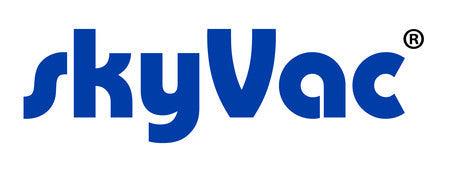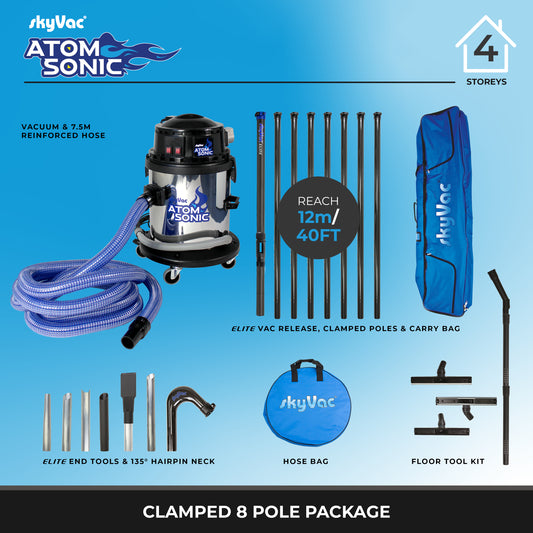Cómo la alta concentración de polvo favorece la eficiencia y el flujo de aire del sistema HVAC
Compartir
La eliminación de polvo a gran altura es un aspecto vital, aunque a menudo se pasa por alto, del mantenimiento de los sistemas de climatización (HVAC). El polvo y los residuos pueden acumularse en las zonas altas, obstruyendo el flujo de aire y reduciendo la eficiencia de los sistemas de calefacción y refrigeración. Al emplear técnicas de eliminación de polvo a gran altura, puede garantizar el correcto funcionamiento de sus sistemas de climatización (HVAC) y, al mismo tiempo, mejorar la calidad del aire interior. En este artículo, exploraremos cómo la eliminación de polvo a gran altura contribuye a la eficiencia de los sistemas de climatización (HVAC) y por qué es esencial para un ambiente interior más saludable.
Conclusiones clave
- La alta capacidad de eliminación de polvo mejora la eficiencia del sistema HVAC al garantizar un flujo de aire sin obstrucciones, lo que genera un mejor rendimiento.
- La limpieza regular de superficies elevadas mejora la calidad del aire interior al eliminar alérgenos y contaminantes de las superficies elevadas.
- Invertir en el equipo adecuado para quitar mucho polvo puede aumentar la seguridad y reducir los costos laborales durante la limpieza.
Comprender el papel de la alta concentración de polvo en los sistemas HVAC
¿Alguna vez te has preguntado por qué tu sistema de climatización (HVAC) no funciona tan eficientemente como debería? ¿O por qué el aire de tu edificio no se siente limpio ? La respuesta podría estar escondida en esos espacios altos, difíciles de alcanzar y a menudo ignorados. Hablemos de cómo la acumulación de polvo juega un papel más importante de lo que crees para mantener tus sistemas de climatización (HVAC) en óptimas condiciones y una calidad del aire óptima.
Mejora de la eficiencia del flujo de aire
La acumulación de polvo en rejillas de ventilación, conductos y otros componentes de HVAC puede afectar gravemente el flujo de aire. Cuando estas áreas están cubiertas de polvo, el sistema debe esforzarse más para impulsar el aire, lo que implica un mayor consumo de energía y facturas más altas. Limpiar regularmente el polvo a alta presión elimina estas obstrucciones, permitiendo un flujo de aire más fluido y eficiente. Piénselo así: ¡una vía de aire limpia es una vía de aire feliz! Al mantener estas áreas despejadas, ayudamos a que nuestros sistemas de HVAC funcionen a su máximo rendimiento, ahorrando energía y dinero a largo plazo. Además, un sistema que no se sobrecarga tiene menos probabilidades de averiarse, lo que nos ahorra costosas reparaciones. Considere usar un sistema de limpieza a alta presión para mejorar la calidad del aire.
Reducción de la acumulación de polvo
La limpieza a gran escala no se trata solo de eliminar el polvo existente, sino también de prevenir su acumulación futura. El polvo tiende a acumularse en lugares inaccesibles (techos, vigas, lámparas) y luego, gracias a la gravedad y las corrientes de aire, se extiende por todo el edificio. Al enfocarnos regularmente en estos puntos de alta concentración de polvo , podemos reducir significativamente la cantidad de polvo que circula en el aire. Este enfoque proactivo se traduce en menos polvo depositado en las superficies, menos alérgenos en suspensión y un ambiente, en general, más limpio y saludable para todos. Es como atacar el problema de raíz, deteniéndolo antes de que se propague. Podemos usar un filtro HEPA para capturar el polvo y los alérgenos.
Beneficios de la alta concentración de polvo para la calidad del aire interior
Mejorar la salud y la seguridad
Todos queremos un espacio que no solo sea limpio, sino también saludable. La acumulación de polvo juega un papel importante en esto. Piénselo: el polvo acumulado en superficies altas no solo es antiestético, sino que también es un caldo de cultivo para alérgenos y otros irritantes. Cuando descuidamos estas áreas, estas partículas pueden circular fácilmente por el aire, afectando el bienestar de todos en el edificio. La limpieza regular del polvo ayuda a eliminar estos contaminantes, lo que mejora la salud respiratoria y reduce los brotes de alergias. Además, no olvidemos la seguridad. La acumulación de polvo, especialmente en lugares como las lámparas, puede representar un peligro de incendio. Al mantener estas áreas limpias, también reducimos el riesgo de incendio. ¡Todos ganan!
Minimizar alérgenos y contaminantes
El polvo no es solo polvo, ¿sabes? Es una mezcla de todo tipo de cosas que preferiríamos no respirar: polen, esporas de moho, ácaros del polvo e incluso caspa de mascotas. Estos alérgenos pueden provocar reacciones alérgicas y síntomas de asma, lo que les hace la vida bastante difícil a algunas personas. Limpiar a fondo el polvo es una forma sencilla pero eficaz de combatirlo. Al enfocarnos en las zonas de difícil acceso donde el polvo se acumula, podemos reducir significativamente la cantidad de estos alérgenos en circulación. Piensa en ello como atacar el problema de raíz. Limpiar a fondo el polvo regularmente también puede ayudar a mejorar el rendimiento del sistema de climatización (HVAC), reduciendo la carga en los sistemas de filtración. Por ejemplo, usar sistemas de limpieza a fondo en espacios comerciales puede mejorar significativamente la calidad del aire al eliminar el polvo y los alérgenos. Y durante el mantenimiento invernal , cuando la humedad es más baja, es el momento ideal para limpiar a fondo para una mejor visibilidad y una limpieza eficaz. Aquí tienes un vistazo rápido a cómo ayuda la limpieza a fondo:
- Reduce los alérgenos transportados por el aire
- Minimiza las poblaciones de ácaros del polvo.
- Mejora la calidad general del aire
Cómo elegir el equipo adecuado para quitar polvo en altura
Bien, ya estamos listos para empezar a limpiar en profundidad. Pero, ¿por dónde empezamos a elegir el equipo adecuado? No es tan sencillo como usar cualquier plumero. Debemos pensar en qué se adapta mejor a nuestras necesidades y a nuestro espacio. Analicemos qué buscar.
Características clave a tener en cuenta
Al comprar un equipo para eliminar polvo a gran altura , hay algunos aspectos que debemos tener en cuenta. Ante todo, debemos considerar el alcance del sistema. ¿Puede llegar a esos puntos altos y difíciles de alcanzar? Piense en los techos más altos o los conductos de sus instalaciones. También debemos considerar la potencia de succión. Una aspiradora débil no será suficiente. Queremos algo que realmente pueda eliminar el polvo y los residuos. La versatilidad es otro factor importante. ¿Puede el sistema manejar diferentes tipos de superficies y tareas? ¿Tiene los accesorios adecuados para todo lo que necesitamos limpiar?
A continuación se muestra una lista de verificación rápida para tener en cuenta:
- Alcance: asegúrese de que los postes o varillas de extensión sean lo suficientemente largos para las áreas más altas.
- Potencia de succión: busque sistemas con altos CFM (pies cúbicos por minuto) y medidas de elevación de agua.
- Accesorios: considere cepillos, boquillas y otras herramientas para diferentes superficies y tareas.
Mejores prácticas para la implementación
Bien, ya tenemos nuestro nuevo y reluciente sistema SkyVac . ¿Y ahora qué? Al igual que con cualquier otro equipo, debemos asegurarnos de usarlo correctamente para sacarle el máximo provecho. Esto implica capacitar a nuestro personal y establecer un buen programa de limpieza. Una capacitación adecuada es clave para el uso seguro y eficaz de cualquier sistema de limpieza a gran escala. No basta con entregarle el equipo a alguien; es necesario que entienda cómo usarlo correctamente. Esto es lo que debe cubrir la capacitación:
- Operación del equipo: Muestre a todos cómo ensamblar, usar y mantener correctamente el sistema.
- Procedimientos de seguridad: Enfatizar la importancia de la seguridad y las técnicas adecuadas para evitar accidentes.
- Técnicas de limpieza: Enseñe los mejores métodos para limpiar diferentes superficies y áreas.
Cuando se trata de limpiar grandes cantidades de polvo, elegir las herramientas adecuadas es fundamental. Necesita equipos seguros, fáciles de usar y que hagan un buen trabajo. Considere lo que necesita para sus tareas específicas, como la altura y el tipo de superficie. ¡No olvide visitar nuestro sitio web para obtener más consejos y las mejores opciones de equipos para ayudarle a elegir la mejor opción!










